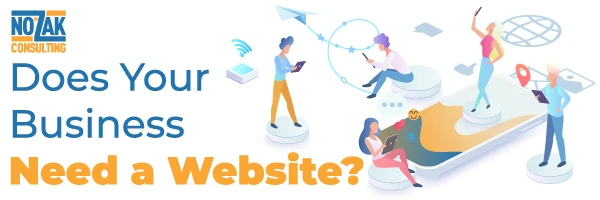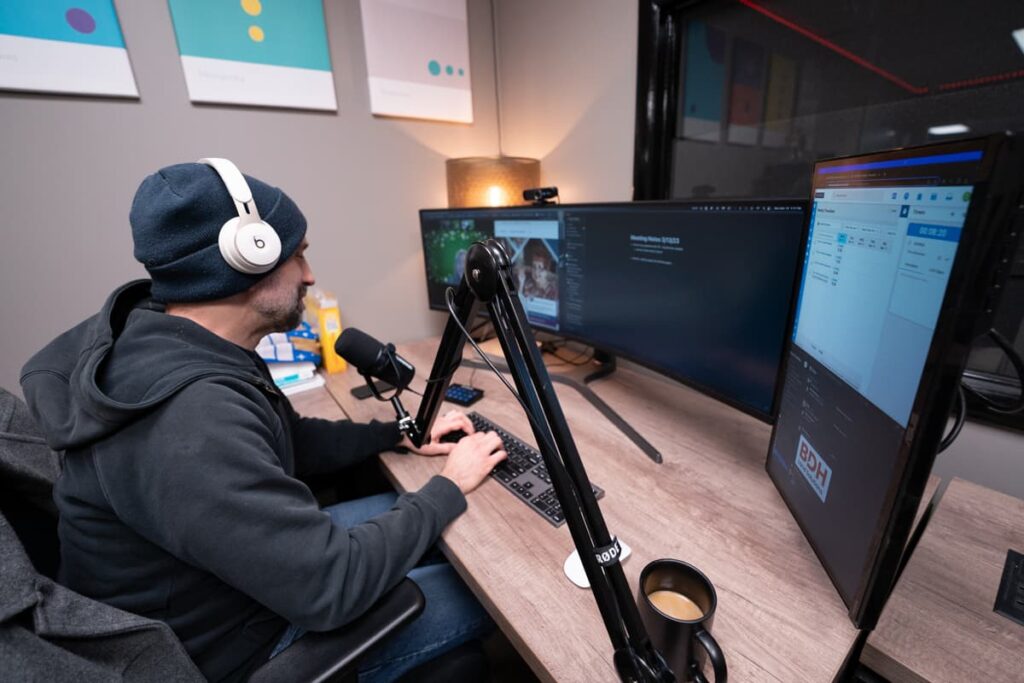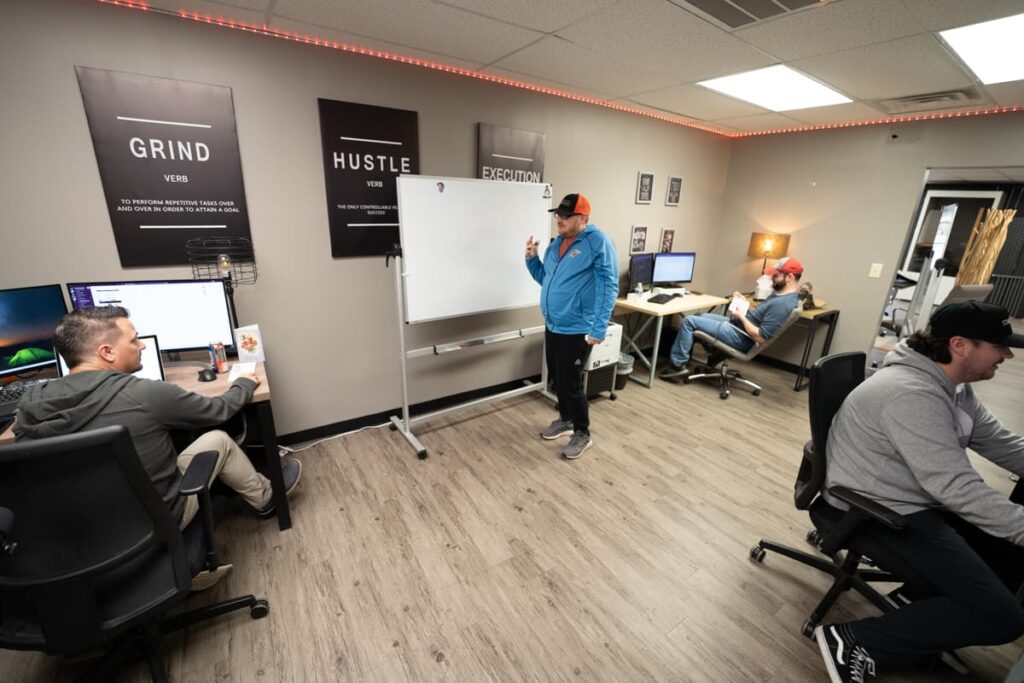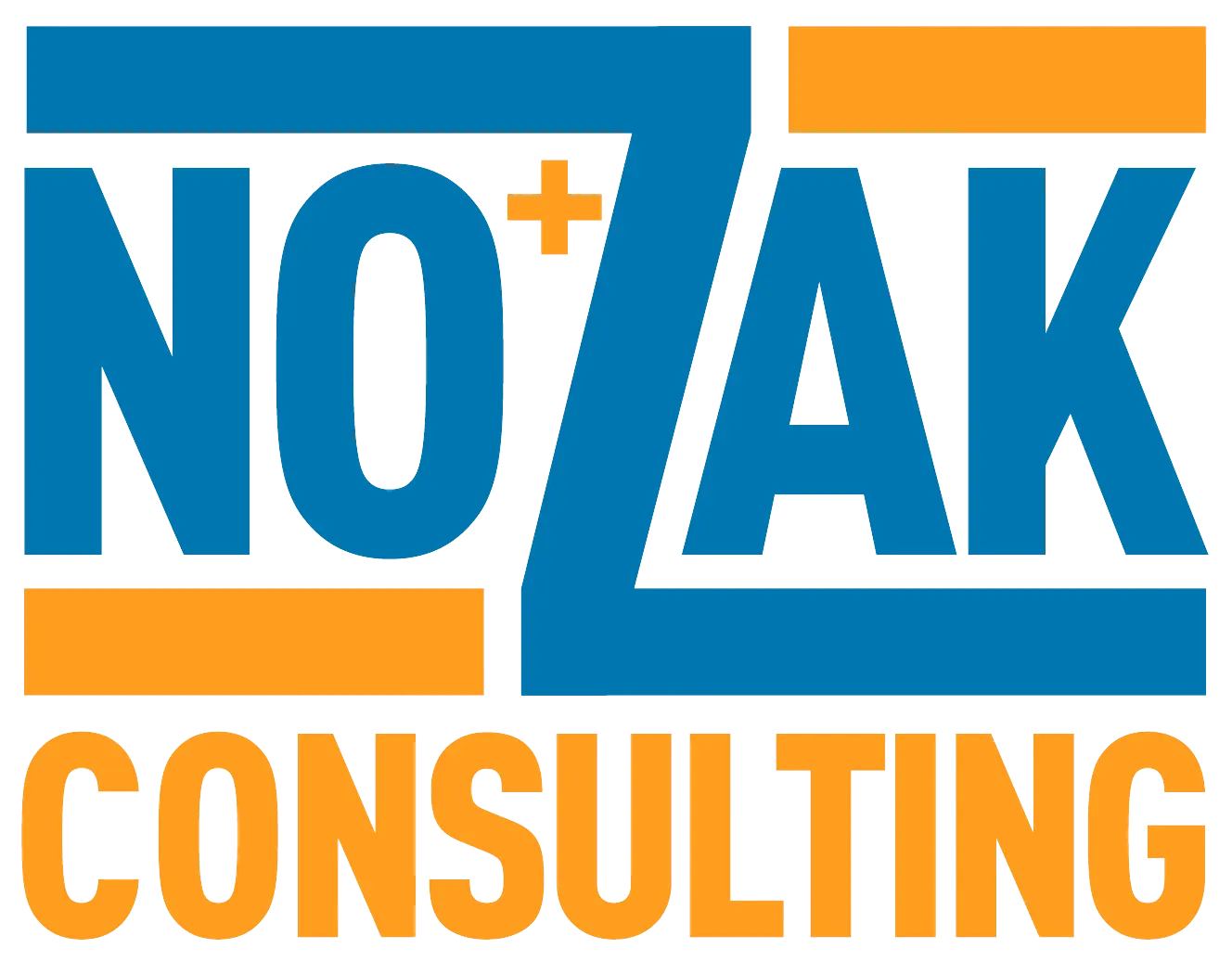Businesses of all types are truly between a rock and a hard place. To be competitive in today’s marketplace, you must be present online. The COVID-19 pandemic has only accelerated this reality.

People are spending more time shopping online, decreasing face-to-face sales opportunities. Many workers continue to work remotely, cutting down on interaction between colleagues and lunch break errands. Previously, they might have asked their coworker to recommend a plumber or dentist.
People are also ordering takeout more frequently, I know I am. They are less likely to browse a new store or notice the business next door to the restaurant when they are on a mission to get their food home quickly. That means your brick-and-mortar business could go unnoticed even if you are in a normally busy part of town. You pay a premium to lease your space in a desirable shopping district, but these rapid changes are threatening cash flow and businesses of all sizes.
Instead, people are relying heavily on Google reviews, search engines, and company websites (social Proof). They are also more likely to crowdsource recommendations from social media sites. (Crowdsourcing was a growing trend long before COVID.)
These behavior changes from consumers aren’t all bad. Some researchers believe that many of these behavioral shifts are here to stay. In fact, companies that embrace these changes have the potential to amplify their growth, SERP positioning, and bottom line.
Businesses with a strong online presence have a leg up on the competition. If you are easy to find online, have positive reviews, and have a great website you’ve already established a tremendous amount of credibility.
The thing is, your website must appeal to two audiences. First, you must have compelling content. Your homepage should clearly articulate your strengths and benefits and then close the deal with a strong Call to Action (CTA). Second, your site must be optimized for search engine bots and users. Your great content and web design will just go to waste if it’s not strategically built to rank high with search engines.
Consider this discovery sequence:
Bob makes a post to his Fantasy Football Facebook group asking his friends to recommend a tire shop. He wasn’t pleased with the service at the company he used last time.
Several friends respond with companies & links. Facebook will automatically link to the companies that have websites. Bob ignores the recommendations without a link (Credibility) because that would require him to leave Facebook, open a browser and search for the company’s name.
Instead, he clicks through two of the linked recommendations. One has a website, but it looks dated and amateurish. He clicks a second link – the website is up to date, mobile-friendly, optimized, and professional (credibility & trust). The business’s address is easy to find and the phone number to make an appointment is right at the bottom of the page.
Not only is this a lead, but it’s also a qualified lead. It’s not a cold call or even a targeted ad. The person on the site is actively looking to engage your services. Plus, you’ve already established some credibility thanks to the vetting via Facebook. Now is the chance to make a great impression and close the deal.
Bob taps the number on the site and calls the tire shop directly. (Sidenote: Hopefully, whoever answered the phone asked Bob HOW he found you. Tracking your sales leads is essential. When you know what lead-generation techniques are working, you can put more resources behind those activities and platforms.)
Over the next several months, other members of the Facebook group return for recommendations (trust & social proof). (Hello…ROI!) Perhaps they made a mental note about the tire conversation thread.
Use Facebook To YOUR Advantage
Facebook is counting on this. In fact, the Facebook algorithm rewards this type of behavior because Facebook needs and wants users to spend more time on the site. Facebook encourages you to crowdsource information just like this. That’s why Facebook makes it possible to search the group’s history and view past conversations. So why not use this to your advantage?
The same lead-generating process repeats itself and three more customers are funneled to the same tire shop.
Do you want to be the company that is skipped over entirely? Of course not. If you’re a small business owner, you might set out to create your own website.

The Problem With A DIY Website
Currently, there are a handful of online platforms that allow you to use a template to create your own website. Some tech-savvy entrepreneurs choose to DIY – especially if they are just starting out and not ready to scale their business.
Problem is, it’s easy to get bogged down in the details of web design. You can spend weeks or months adjusting, rearranging, and designing your site. You can invest entire workdays, nights, and weekends into your site’s development but it still doesn’t look as polished as you’d like.
If you’re the business owner who is ready to scale your business, you’ve already outgrown the DIY model. You understand the value of delegation and business management. The time you’d spend tinkering with your website is better used investing in and running your business.
As a modern business owner, you recognize the importance of brand messaging, content additions, website adjustments, photo optimization, product descriptions, typography, and color pallets. But, it’s “too in the weeds.” You are focused on the big picture stuff.
After all, that’s the reason you are the business owner! You have a business to manage and every hour you devote to messing with your website or keeping up with Google algorithm updates is an hour you could have used to work on processes, systems, payroll solutions, product development, sales, or another area that will also require your time and energy.
Building a good website – one that looks great and performs well is part art and part science. An entire team of researchers, writers, web developers, and project managers come together to build a Search Engine hungry site. And what exactly is an SE Hungry site? It’s a site that’s optimized to perform well with search engines.
More on that later…
You get it. You understand that outsourcing your website design can be a smart move. So, you call up your local ad agency.
Should You Hire An Ad Agency to Design Your Website?
It takes a few weeks to get an appointment, but when you do you are taken to a conference room with a large tray of danishes and an expensive-looking espresso machine (nothing wrong with that as long as they clean the filter regularly). You always knew that people working in advertising were trendy, but apparently, a black turtleneck and a caffeine addiction are also a requirement for this line of work.
Your account representative walks you through their branded slide deck. It vaguely reminds you of the latest iPhone launch. The ad agency team outlines the website building process in a perfectly choreographed routine. The presentation is certainly impressive, but when it came time to discuss numbers there was an extra zero on the price tag that you were not expecting. Plus, development might take a year or more. Ouch. It’s not a good fit.
Publicly traded companies and other large organizations have entire divisions dedicated to their websites. These websites are incredible and win awards. They are interactive works of art.
In most cases, you get what you pay for. But, even the companies who throw hundreds of thousands of dollars at their web design can still find themselves on page 2 of Google’s search engine results page (SERP) if they don’t have a highly skilled SEO strategist guiding the development.
Syd and Shea McGee, the design duo with a hit HGTV show and a home decor product line in Target, wrote an autobiography detailing how they built their wildly successful business. In Make Life Beautiful, the McGees shared they paid a reputable web design firm upward of $200k to create their eCommerce site.
After months and months of development and just prior to their anticipated launch, they realized their site did not function as it should. It was clear they needed a major course correction.
They cut ties with their old agency and started fresh with a new development team. The McGees were contractually obligated to pay for the first site even though it was unusable. They couldn’t get their products to market without the site. They had to cut their losses and try again.
Goldilocks and the Three Web Designers
Are you starting to feel like Goldilocks? The DIY option was too small, the ad agency was too big. What can you find that will be just right?
Enter the freelancer. He’s a one-man band – web designer, branding strategist, and self-proclaimed SEO expert all in one. The price is right and he says he can build your site relatively quickly.
But, before you sign on the dotted line, you have some concerns. Is it wise for your entire site/strategy/brand to be dependent on one person? Does he have the experience he says he does? She has 20 years of experience, so certainly she must know something! What if the business relationship goes sour…could he just shut down your site? How would I get the keys to the kingdom if the relationship needed to end?
Your gut tells you there are just too many variables and too few ways to course-correct if there is an issue.
We’ll be honest, handing over your entire branding strategy, website design and SEO efforts to a single person is a big risk and quite frankly, a bad decision. Websites require updates, strategy and process improvements – even if the site was built following all of the best practices. If the freelancer stops working or is unable to finish the project for any reason, you’re left to pick up the pieces. Not to mention timelines, fixes, updates are all on their availability!
Sure, there are plenty of well-qualified freelancers who are great for a one-off project. If the person you hire is able to deliver on their promises; it can work out. But all too often we hear these same scenarios from prospective clients each month – their site hasn’t been updated in years, they’re stuck with an outdated platform that is no longer functional and they are disappointed from unmet expectations.
While we would love the opportunity to swoop in to be the hero for your business, we hate to see the financial risk, stress and turmoil these scenarios often create for business owners. The stakes are just too high when it comes to your company.
Is an SEO-Optimized Website Even Worth It?
After all of this, anyone would be tempted to throw up their hands in frustration. Maybe a website isn’t worth it. The time – the money – the risk – it’s all too much.
You have great sales, you consistently get word-of-mouth referrals and you’ve recently created a Business Page on Facebook.
Maybe you should forget the website completely and put your efforts into social media. Your college-aged niece is studying Public Relations. Maybe she could amp up your social media efforts. She is always talking about “content that goes viral.”
The Social Media Myth
You’ve heard it before – social media is king. If you talk to anyone below the age of 30, they’ll tell you that “going viral” is everything. Young people today want to be influencers and Youtube stars.
Even reputable business books and business leaders proclaim the importance of “engaging customers through social media.” If you’re not on social media sites like Facebook, Instagram, and TikTok, how are you going to attract new business? These gurus tell you to grow your following, engage with customers and create viral content.
A quick visit to any of the social media platforms only confirms the message behind this strategy. Facebook and Instagram are filled with ads and links to all kinds of consumer goods – clothes, gifts, home goods, and foodservice subscriptions.
Companies spend millions of dollars crafting their online image and partnering with the right “influencers” to promote their brand.
Clearly this strategy works…
Except it also doesn’t.
Social media is great if you need to direct traffic to your online store or boost brand recognition for your latest product.
But social media virality is not applicable to many businesses. Yet, companies keep trying to make social media virality a part of their marketing strategy.
This is why your dentist is now on Instagram, your exterminator invited you to like his Facebook business page and your lawn service company keeps trying to make a viral video. We have to keep social media in perspective – it is a signal of activity, a place to run ads, grow brand awareness, but in most cases it is not a silver bullet – it is a line item in the marketing mix.
Do an audit of the engagement created by business social media accounts, it’s modest at best – at least compared to the effort that goes into content creation. It’s a whole lot of energy and effort for very few likes. A strategy with the goal of virality is almost always going to fail – but a social media strategy that strengthens an entire digital footprint actually has purpose.
The “viral strategy” isn’t effective for most businesses for several reasons:
1. Your Content Isn’t the “Right” Content
How does a company that specializes in septic tanks or orthodontics engage with social media users in a way that should ever be viral? Some things just don’t lend themselves to pictures and video.
2. Creating Viral Content is Difficult
It’s extremely hard to create “viral” content for most businesses. Your staff probably doesn’t want to learn the latest TikTok dance. Editing videos, creating stories and other shareable content requires decent production quality. The contributors that make everything look so “effortless” actually have lighting, editing programs, and styled photoshoots behind the scenes of their viral campaigns. Without these efforts, your content will look amateur by comparison.
3. Creating Social Media Content Is Incredibly Time Consuming
Social media algorithms reward creators who regularly upload content and punish those who post intermittently. That means you have to continue to “feed the machine” to keep up with your social media success. It can become an incredible time suck – and many successful creators & influencers have actually stepped away from their social media business because of this constant drain.
Social Media Isn’t a SOLE MARKETING STRATEGY For Your Business
If you can create good, shareable content, that’s great! We encourage it! But in many cases, it will mostly serve as a moment of credibility and it certainly can be a signal for your search engine rankings. Social media must be executed in conjunction with a robust digital marketing strategy. It is not the sun in the solar system, the website is.
Even when social media drives traffic, leads, and conversions – it is still a byline in the marketing mix and a strategy that could dry up at any moment. Nothing in marketing is ever static, this is why we must always place the website at the top of our digital marketing assets – because we will ALWAYS OWN it. And in the end, one email/signup from a website probably has the same value as hundreds and in some cases thousands of page likes.
When it comes to searching for a service, the order of importance is going to be local SEO (GMB/website), SEM /SEO (ads & website), social media (active branded channels).
Choose a Holistic Strategy that is Right For Your Business
As you know, there are entire industries that don’t see much benefit from social media. The point here is not that all social media is bad or that you should delete your business social media accounts altogether (the exact opposite). Rather, you don’t want your primary marketing strategy to be centered around social media – but to be well rounded.
So, what are companies supposed to do? What are you supposed to do?
You need a more purposeful website. ALL companies need a website. I am yet to find a company that doesn’t benefit from a great SEO strategy and a professional website.
If you want to grow your business, scale your business, and protect your business from market fluctuations, you need a great website.

Why Websites Win
Whether your company completes the sale on your website, boosts your reputation, or leads your sales target one step further down the sales funnel – your website is your greatest marketing asset. YOUR LIST IS TOO!
Simply put: Websites Win
How to Get People to See Your Website
As you know, a website doesn’t exist somewhere on the internet all alone. For your website to be effective, you have to get people to see your website. In other words, you must have strategies that direct traffic to your website. You must get actual people to visit your web pages.
Website traffic comes from:
- Search Engines
- Social Media
- Content Links
- Profiles & Directories
- Email Marketing
- Advertising
- Crawlers/ Mystery Traffic Phantoms
Organic Traffic vs. Paid Traffic
Generally, traffic sources can be broken down into channels. Organic Search, Direct, Paid Search, Display, Referral, Other, Social, etc.
The largest channels are really an extension of your active marketing strategies. Organic is that unique one though. Organic traffic, unlike paid & display, refers to the visitors that land on your website as a result of unpaid search results. Visitors who are considered organic find your website after using a search engine like Google, Yahoo!, DuckDuckGo, or Bing, so they are not “referred” by any other website (referral traffic).
The search engine results page (SERP) is a highly competitive space. The higher your business ranks at the top of the page, the greater the chance that users will click on your link and be directed to your page.
Search Engine Optimization (SEO)
Search Engine Optimization (SEO) is the process of improving your search engine ranking along with the quality and quantity of your website traffic from search engines. You, along with all of your competitors, are vying for the top spot on the SERP. SEO all starts with the website.
Organic SEO focuses on making the writing on your website more attractive to search engine spiders, also known as web crawlers. These tools are internet bots that crawl and analyze websites. The bots use information about your site to determine what search results will be relevant to a user’s search request.
How do they do this?
- Crawling: They scour the internet for content, looking over the code and content of each URL they find.
- Indexing: They store and organize the content found during the crawling process. Once a page is in the index, it has the opportunity to be displayed as a result to relevant queries. If you haven’t been indexed, you won’t show up at all.
- Ranking: The bots organize the pieces of content that will best answer a search query, which means the results are ordered from most relevant to least relevant.
What these bots look for continually changes. That’s why it’s important to track your SEO strategy and evolve with the changes. One of the biggest ways you can boost your organic SEO is by beefing up your website.
You can add additional web pages, you can increase the amount of text on your existing pages and you can add a blog. Not only will potential customers find this information useful, but the bots will recognize that the content is rich with relevant keywords and helpful to readers.
For example, we have the ability to research WHAT questions people are typing into the Google search bar. Then, we can write content that directly ANSWERS those questions. The Google bots read that information and rank your site higher because it’s helpful and relevant to Google users. In this example, it’s all about working smarter, not harder.
Paid SEO/ Paid Traffic
Paid traffic, as you might expect, comes from paid ads or a paid search campaign. One of the most common forms of paid traffic is Search Engine Marketing (SEM).
Search Engine Marketing
With SEM, you pay for your website to appear as an ad on the search result search engine results page (SERP). Your ad looks nearly identical to organic search results.
You select target keywords so that when a user searches for those terms, they see an ad from your brand. You are charged only when a user clicks on the ad. Paid search ads can be found on almost any search results page.
Display Advertising
Display advertising places banners or other ads on websites with audiences that are interested in your product.
Remarketing Ads
Remarketing allows you to advertise to people who have previously visited your website by showing them relevant ads when they visit other sites or search on Google.
What’s Better: Organic or Paid Traffic?
That’s a great question. Often, the answer to the paid vs. organic traffic question isn’t either/or. A good SEO strategy strikes the right balance between the two.
When determining what approach to take, your SEO specialist will take into account:
Your Budget
If you don’t have any room in your budget for ongoing paid ads, you would need to focus on organic SEO. Ideally, you could have some margin for both.
Your Long & Short-Term Goals
Pay-per-click (PPC) campaigns and SEO campaigns drive different kinds of traffic to your website. Are you primarily interested in short-term conversions and/or product sales? (Think: retail and products: clothes, toys, low-cost items.) Then, your mix would rely more heavily on PPC advertising.
Are you more interested in building a lot of traffic over time and establishing trust with your visitors? (Think: Businesses that need a great reputation: Restoration companies, plumbers, etc.) Then, you would lean more toward a solid SEO strategy.
The Competition
PPC platforms use bids, not fixed prices to set the rate you will pay per click. Some industry words are much more expensive than others. The more expensive the word, the more likely you should rely on SEO to deliver traffic and leads to your organization.
But before you can even begin to figure out any of your SEO strategy…
YOU HAVE TO HAVE A WEBSITE.
If you’re going to create a website, you might as well create a good one. If you’re going to invest time, money, and energy into this project, you want to make sure it’s going to actually boost your business.
That means you want to focus on the front AND back end of your website.
Front End vs. Back End of Your Website
The front end of your website is what users will see. It’s the visual elements – the color, design, logo, writing, and pictures. It’s your branding. It’s your messaging.
The back-end of your site is what servers see. It’s the coding and development that help your site display correctly to users. Back-end development is also what makes your site attractive to those bots that are so critical to your SERP ranking. There are literally thousands of tiny changes you can make on the back end that will improve how much traffic is directed to your site.
This is why if you choose to go the DIY method you can find yourself spinning your wheels. Or you can pay someone lots of money to create a beautiful site with great pictures, eye-catching colors and the latest font – but then it underperforms. Few people ever make it to see the site!
Full-Stack Development
If you are going to create a website, you need full-stack development. You need a team that will address your front-end and back-end needs.
Yes, I said TEAM. That’s because the type of person that is really good at the back end stuff is typically not the type of person that is great at the front-end branding stuff. (Engineer vs. writer).
When you have a full-stack team attacking your website, you get the best of both worlds. You get a clean, easy-to-read, appealing site. You also get a site that attracts search engine traffic.
Sprinkle in some Search Engine Marketing (SEM), positive Google reviews, and remarketing ads and you will be ready to grow and scale your business.

Nozak Consulting
At Nozak Consulting, we don’t just build websites, we build websites that perform. We address the front and back end of your site as well as paid and unpaid SEO for a comprehensive web marketing strategy.
We’ve developed a process that allows us to work on the front and back end of your website simultaneously. The day you begin our client onboarding process, we set to work.
Immediately, our content team works to pull together your branding with:
- Logo Design/ Adjustments
- Visual Branding Guide
- Web Content & Voice Guide
- Value Proposition Development
- Website Design Mockup
Meanwhile, our backend team sets to work on:
- Research
- Server Setup
- SSL
- Staging Environment
- Backups
- HTML Sitemap
- Google Analytics
- Data Studio Dashboard
- 404 Audit
- Yoast Audit
- Ahrefs Audit
- Google Lighthouse Audit
- Screaming Frog Audit
Within 90 days you can have a site that builds trust, boosts your credibility, and drives sales.
Data-Driven
Our approach begins with research. Before we can make recommendations or changes, we audit your current site and analyze your traffic. We also take a look at your competition. We determine what keywords you need to be targeting and what digital marketing strategy will work best for your unique business.
Strategic Messaging
As we learn about your business, our writing team develops the strategic messaging that will be featured on your home page and interior pages of your website and blog. We focus on your value proposition and target audience as we craft the writing that will be featured in your digital content and any marketing collateral.
Continuous Improvement
You can never truly be “done” with SEO. To develop a baseline, our team will analyze your web traffic to figure out what’s working, what’s not, and what can be improved. As we build your site, we will make adjustments and run test campaigns to enhance your SERP and ad performance.
Your site is not stagnant. We will make changes to respond to incoming analytics, algorithms changes, and even changes from your competitors. We will evolve and adapt to what’s happening in real time.
When Is the Best Time To Create a Website?
Whether you have an existing site or need to start from scratch, it’s obvious that a website is your most important marketing asset.
Many people assume they can wait until “things slow down” around the office or wait for a slump in sales to invest in marketing.
Unfortunately, if you wait until your company is in trouble, you may have waited too late. It is always better to be proactive than reactive. While we pride ourselves on how quickly we can start building your website, it still takes several months to see the full potential of the changes we put in place.
If you wait until you recognize that you have a problem with sales, then take even more time to determine the right course of action you’re already behind the curve. Don’t wait until you are in a crisis to get started.
At Nozak Consulting, we are ready to help your business dominate your marketplace by leveraging the power of search, building your brand online, and growing your business with proven digital marketing strategies.
Get started today!
